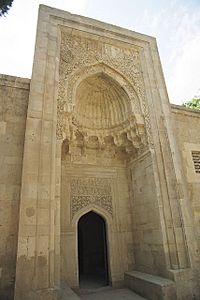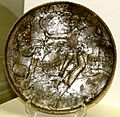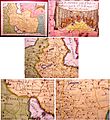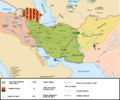History of Azerbaijan facts for kids
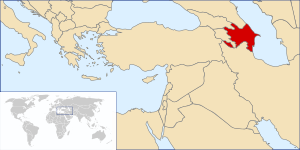
The history of Azerbaijan is very ancient and goes back to the Stone Age.
Contents
Early history
The name Azerbaijan has existed for many centuries, although its spelling often changed throughout its history. Historical sources show the former names of Azerbaijan as Andirpatian, Atropatena, Adirbijan and Azirbijan. The most ancient archaeological and paleontological materials found recently on the territory of Azerbaijan prove that Stone Age people settled here 1.7-1.8 million years ago. The early civilizations such as Mana, Scythia, Atropatena and Caucasian Albania appeared on the lands of Azerbaijan from the 1st millennium BC. Caucasian Albania was relatively independent under Roman and (Persian) control.
Middle Ages and the coming of Islam
In the 7th century, Islam was introduced with the Arab conquest, which was important in the formation of a single nation and language in Azerbaijan, when the population became Muslim. A common religion for both Turkic and non-Turkic ethnic groups brought about the formation of common traditions, and the integration between the different ethnic groups living on the territory of Azerbaijan. By the middle of the 9th century, the Turkic ethnic group, the Azerbaijani people became the major ethnic group.
The establishment of a single state in Azerbaijan happened between the 15th century and the 18th century. This period is very important in the history of Azerbaijan. The ruler Shah Ismail Khatai (1501-1524) who was of Azerbaijani origin, united all the territories of Azerbaijan under his control. He founded the Safavid dynasty with Tabriz as its capital. During the rule of the Safavis, the Azerbaijani language also became the only official language. After the Safavid dynasty ended, Nadir Shah Afshar (1736-1747), an Azerbaijani commander founded the Afsharid dynasty (1736-1796) named after himself, and continued to rule over Azerbaijan's territories. He strengthened the borders and in 1739 invaded North India including Delhi. After Nadir Shah's death, his dynasty weakened and in the second part of the 18th century resulted in the formations of new smaller states.
In the late 18th century, then, the government of Iran passed to the Qajar dynasty (1796-1925), who were also of Azerbaijani origin. Their main policy was to unite all the territories once ruled by their ancestors. This gave the start to several long wars between the Qajars and Russia, with both parties aiming to occupy the South Caucasus which Azerbaijan is a part of. Azerbaijan was divided between the two empires. The northern part of Azerbaijan was annexed to Russia, while the south went to Iran. This is the origin of today's political division between "North Azerbaijan" which today has become the Republic of Azerbaijan, and "South Azerbaijan", which today is a part of Iran.
Russian and Soviet rule
Azerbaijan came under Russian rule after the Persian-Russian wars of 1804-1813. The country gained independence for a short period, however, towards the end of the First World War. After the collapse of the Russian Empire in 1917, Azerbaijan, together with Armenia and Georgia became part of the short-lived Transcaucasian Democratic Federative Republic. When this republic ended in May 1918, Azerbaijan declared independence as the Democratic Republic of Azerbaijan on May 28, 1920, which was the first modern and secular parliamentary republic in the Muslim World. However, the Red Army occupied the territory and annexed it to the newly formed Soviet Union and the Azerbaijan Soviet Socialist Republic was founded on April 28, 1920. During the Second World War and after, the Azerbaijan SSR played as a petroleum producer, an important role in the energy policy of the Soviet Union. Following the politics of reforms called "glasnost", started by the leader of the Soviet Union Mikhail Gorbachev, riots and ethnic fighting grew in various regions of the Soviet Union, including Nagorno-Karabakh, a region of the Azerbaijan SSR. The disturbances in Azerbaijan, in response to the Soviet government's lack of response to the already tense conflict between the Azerbaijanis and Armenians, resulted in calls for independence and secession, which resulted in the massacre known as "Black January" in the capital Baku in January 1990. Azerbaijan eventually declared independence on October 18, 1991. The Soviet Union was ended on December 25, 1991.
Independence
|
When Azerbaijan became independent, the conflict with Armenia over Nagorno-Karabakh turned into the Nagorno-Karabakh War in 1991-1994.
The politician Heydar Aliyev became the President of Azerbaijan in 1993 and successfully stabilized the country and a ceasefire between Azerbaijan and Armenia was signed in 1994, which ended the war. However, 20 % of Azerbaijan is still occupied by the Armenian military and the two countries are in a state of war. Nevertheless, representatives of the governments of Armenia and Azerbaijan have since been holding peace talks organized by the Organization for Security and Co-operation in Europe (OSCE) "Minsk Group" to solve the conflict and restore the territory to Azerbaijan. When Heydar Aliyev died in 2003, his son Ilham Aliyev became the President of Azerbaijan and is continuing his father's policies today. As an important producer of petroleum and natural gas, Azerbaijan's economy is increasing very rapidly every year, and has become rich as a result.
Images for kids
-
The Median Empire around 600 BCE
-
Sasanid silver plate from Shamakhi District (Azerbaijan State Museum of History)
-
Momine Khatun Mausoleum in Nakhchivan
-
Qajar-style painting of mullahs with the shah
-
The Caucasus after the Treaty of Gulistan, in which Persia ceded most of its northern khanates to Russia after the first Russo-Persian war
-
Mammad Amin Rasulzade, a founder and spokesperson of the Azerbaijan Democratic Republic in 1918, was widely regarded as Azerbaijan's national leader.
-
Heydar Aliyev during a 1997 Pentagon visit
-
Ilham Aliyev in Munich in 2010
See also
 In Spanish: Historia de Azerbaiyán para niños
In Spanish: Historia de Azerbaiyán para niños


